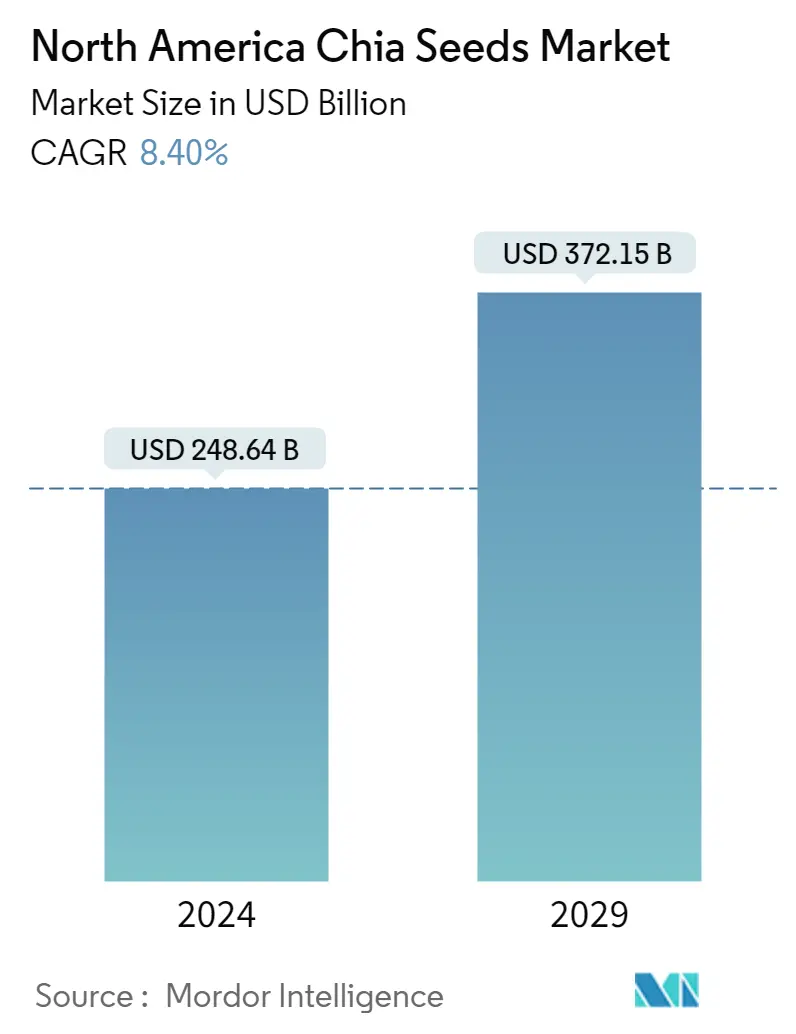Market Size of North America Chia Seeds Industry

| Study Period | 2019 - 2029 |
| Base Year For Estimation | 2023 |
| Forecast Data Period | 2024 - 2029 |
| Market Size (2024) | USD 248.64 Billion |
| Market Size (2029) | USD 372.15 Billion |
| CAGR (2024 - 2029) | 8.40 % |
Major Players*Disclaimer: Major Players sorted in no particular order |
North America Chia Seeds Market Analysis
The North America Chia Seeds Market size is estimated at USD 248.64 billion in 2024, and is expected to reach USD 372.15 billion by 2029, growing at a CAGR of 8.40% during the forecast period (2024-2029).
COVID-19 seriously affected the production, certification, distribution, and cost of seeds by restricting the transportation of the seeds to curb the spread of the virus. This presents a problem for all countries but is likely to have a greater impact in developing countries, which may be particularly hard hit by the economic downturn and relatively more reliant on agriculture. Depending on how long the pandemic and associated confinement measures continue, the seed sector and its associated supply chains could feel the impact of COVID-19 long into the future.
In North America, Mexico was the largest producer of chia seeds, with 2,893.4 metric tons produced in 2018, and it accounted for around 99% of production in the region. Chia seeds do not follow the commoditization trend, as the market is still small, where supply is unstable, and there is a lack of awareness of the high-quality standards demanded by large industries. However, as more consumers are now aware of chia seeds and their benefits, the market is likely to witness tremendous growth in North America. Organic and non-GMO variants are the emerging trend for chia seeds. In terms of product launches, chia seeds are used as a functional ingredient in various bakery products, muesli bars, peanut butter, cereals, and other food products. The main hurdle to the Canadian chia seeds market is their high price, due to which chia seeds can easily be replaced by alternative seeds with similar health benefits, like flax seeds, in the country.
North America Chia Seeds Industry Segmentation
Chia seeds are derived from the desert plant Salvia Hispanica, which is a member of the mint family. Salvia Hispanica seed is often sold under its common name chia. The report defines chia seed as a commodity in terms of end users. To eliminate any double-count error in the market estimations, bulk buyers that procure chia seed products for retail sale, after value-addition, through further processing, are not considered a part of the chia seeds market report. The report offers size and forecasts for the North American Chia Seeds Market in volume (metric tons) and value (USD million) for all above the segments.
| Geography | |
| United States | |
| Canada | |
| Mexico |
North America Chia Seeds Market Size Summary
The North America Chia Seeds Market is poised for significant growth, driven by increasing consumer awareness and demand for chia seeds as a health food. Despite the region's minimal production, with Mexico being the largest producer, the market is characterized by high imports from countries like China, Paraguay, and Argentina. The seeds are gaining popularity due to their nutritional benefits, including high protein, omega-3 fatty acids, and fiber content, which are being highlighted by retailers to attract health-conscious consumers. The market is also witnessing a trend towards organic and non-GMO variants, as chia seeds are increasingly integrated into various food products such as bakery items, muesli bars, and cereals. However, challenges such as high prices in Canada and the lack of awareness about quality standards in the industry continue to pose hurdles to market expansion.
The impact of COVID-19 on the chia seeds market has been notable, affecting production, certification, and distribution due to transportation restrictions. This has led to a reliance on imports to meet the growing demand in North America. The United States, in particular, has seen a rise in chia seed consumption, with the seeds being marketed as superfoods and incorporated into health and food trends like snacks and energy drinks. Innovations in processing, such as the separation of mucilage to create protein-rich chia seed flour, are further enhancing the market's potential. Despite the challenges, the chia seeds market in North America is expected to experience robust growth, supported by increasing consumer interest and ongoing product development.
North America Chia Seeds Market Size - Table of Contents
-
1. MARKET DYNAMICS
-
1.1 Market Overview
-
1.2 Market Drivers
-
1.3 Market Restraints
-
1.4 Value Chain/Supply Chain Analysis
-
-
2. MARKET SEGMENTATION
-
2.1 Geography
-
2.1.1 United States
-
2.1.2 Canada
-
2.1.3 Mexico
-
-
North America Chia Seeds Market Size FAQs
How big is the North America Chia Seeds Market?
The North America Chia Seeds Market size is expected to reach USD 248.64 billion in 2024 and grow at a CAGR of 8.40% to reach USD 372.15 billion by 2029.
What is the current North America Chia Seeds Market size?
In 2024, the North America Chia Seeds Market size is expected to reach USD 248.64 billion.

